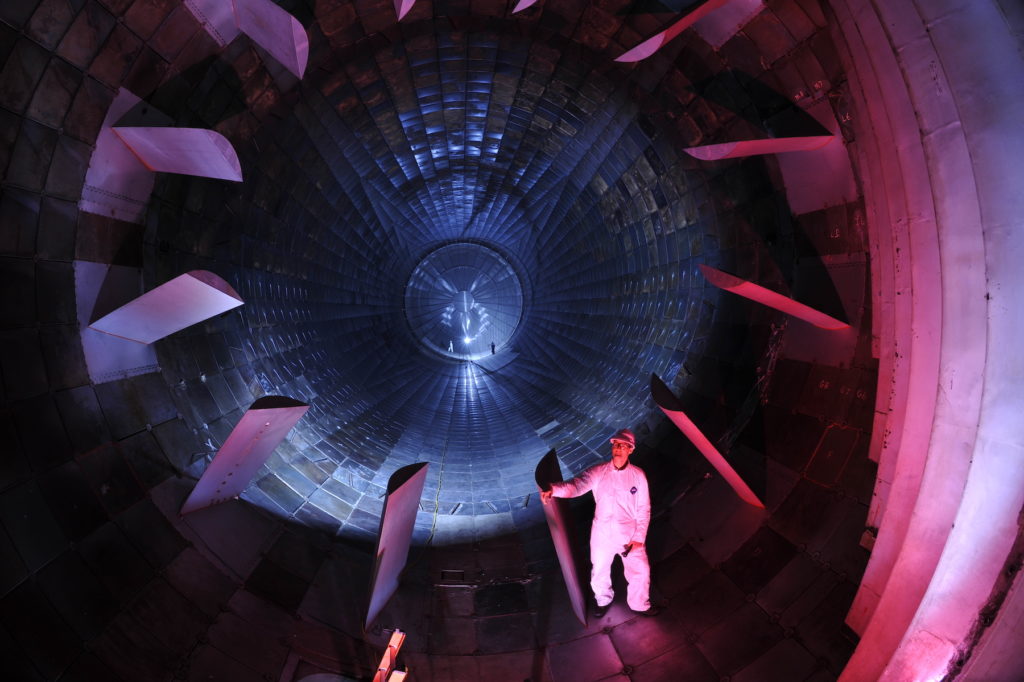
A military wind tunnel in Tullahoma that sat dormant for decades has now become a key player in a global technology race between the U.S., Russia and China to develop airplanes and missiles that can travel at hypersonic speeds.
That’s even faster than supersonic — or more than four-and-a-half times the speed of sound.
Built in 1960 amid the Cold War, the “16S” wind tunnel at Arnold Engineering Development Complex tested high speed war planes and projectiles until 1997. Since then, however, it stood mostly unused, other than occasionally opening to tourists and school groups.
Until recently. The first stage of a tunnel renovation was completed in 2021 and cost $60 million. That moved the 16S tunnel closer to hypersonic capability, although it’s not there yet. Recent international developments make the project even more time sensitive.
Size matters
In February, Lt. Col. John McShane, chief of the base’s Aerodynamics Test Branch, led WPLN News through a tour of the revamped facility. The inside of the tunnel building looks like a 1960s space station, with a curved metal roof lined with little square insulation panels. It looks like a giant quilt in varying shades of gray, as the metal has become discolored over the years.
The tunnel itself is a 92-foot rectangular box running through the center of the space. The walls of the nozzle — sheets of metal an inch thick — move to adjust the speed of the air. The narrower the opening the air is squeezed through, the faster it travels.
The wind tunnel at Arnold Air Force Base is the largest in the world of its capabilities — its cross-section is 16 by 16 feet. That’s still not large enough to hold an actual fighter jet, for example, but size does matter when it comes to wind tunnels. Large facilities can accommodate bigger scale models for testing, which leads to more accurate results.
And there is a lot at stake. McShane describes some of the things that can go wrong when dropping bombs at high speeds.
“The weapon would come off the aircraft and sometimes just spin out of control … or in the worst situation, the weapon would come off and actually hit the aircraft and could destroy the aircraft.”
Evolving technology
The U.S. military has gone through several technological preoccupations over the years.
In the 1950s, it was about having planes that could fly so high that they’d elude detection. That idea fell out of favor when a high-flying U-2 spy plane flown by Francis Gary Powers was shot down by Russia in 1960.
Then it was satellites. But those have a few drawbacks: First, they run on a set course, so countries that want to avoid detection can cover up whatever the satellite is looking for when it’s overhead. In addition, satellites can be shot down.
From the late 1950s through the 1990s, the U.S. invested in stealth technology — technology that allowed planes to be almost undetectable by radar systems. But it’s been in use for decades, and many countries either have stealth technology themselves or have developed counter-measures to get around it.
The next phase, says Dr. Mark Lewis, former director of defense research and engineering at the Pentagon, is hypersonics.
“From a military standpoint, if I had a hypersonic airplane, I might be able to use it for intelligence gathering, for sensing, for surveillance … if it’s a fighter jet, for example, you’d want to go supersonic to be more effective in combat, to evade enemy defenses, for engagements with other aircraft,” he says.
But though the U.S. was the first to develop the field of hypersonics, beginning in 1948, the Russians and the Chinese have since produced hypersonic weapons that can be deployed on the battlefield.
“It’s a field we really invented,” Lewis says, “but we don’t have systems yet that a U.S. military commander can use.”
Rising pressure
The Russian military claims to have used the first hypersonic weapon in combat in Ukraine on March 19. Some analysts dismissed the move as saber-rattling, while others said it may have been a sign they had run out of more traditional ballistic missiles. Still others said Russia may have wanted to increase pressure by showing a hypersonic weapon that could later be fitted with a nuclear warhead.
In a military parade in 2019, China also showed off a hypersonic ballistic nuclear missile. Those countries’ acquisition of these weapons has led to an arms race mentality among the U.S. armed forces and the revamping and construction of wind tunnels across the country to ramp up testing of hypersonic planes and missiles.
The tunnel in Tullahoma is set to be used by U.S. manufacturing giants Raytheon, Lockheed Martin and Boeing, and other companies all the way down the aerospace supply chain. And while these are private companies, the money to operate and run the tunnel is allocated by Congress through two funding streams: one, that allots money to Arnold Airbase itself for the tunnel’s upkeep, and another that gives money to the companies in the form of defense contracts, which is used to fund the tunnel’s running costs.
The tunnel takes an enormous amount of energy to operate. “It used to be this place would be equivalent to like the city of Nashville would be burning power-wise,” says Scott Meredith, a Department of Defense tech advisor who works on the tunnel.
So far, the upgrade in Tullahoma has replaced the wind tunnel nozzle’s drive motors and updated the controls from analog to digital. But the ultimate goal is to equip the tunnel with hypersonic capabilities to test planes and missiles traveling over four-and-a-half times the speed of sound.
And though much of the work within the airbase is classified, the tunnel itself can often be heard from the highway as it hums in the background of daily life in Tullahoma.

